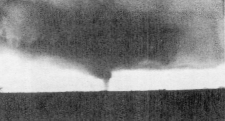B. The Tornado:
Tornadoes vary greatly in appearance and intensity, ranging from the violent type
(pictured on the cover) to the very weak and short-lived ones that last only a few
seconds. in addition, a tornado's do's appearance frequently changes during its life
cycle. Figure 4 shows a multiple vortex tornado which is composed of several small
but intense vortices which revolve around a common center. These small vortices may
develop and dissipate very quickly. At times, rainfall is drawn into the tornado's
circulation, making it very difficult to see. While this is common In the Southeast United
States, it is not limited to that area as illustrated by the Kansas tornado in Figure 5.
In Figure 6, we see a tornadic dust whirl. it should not be confused with a dust devil
which usually occurs on nearly cloudless and warm days having light winds. The first stage
of tornado development is often a dust whirl at the ground with or without a funnel aloft.
The tornadic dust whirl in Figure 6 did not develop beyond this initial stage. It is
common for flanking line dust whirls to form along the gust front; these generally remain
weak and short-lived. |
|
FIGURE 4
 |